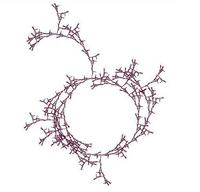
CS 200: Computer
Science
Department of Computer Science
University of Virginia
Circle Fractal by Ramsey Arnaoot and Qi Wang
Using these Materials
|
CS200: Computer Science, Spring 2003
|
Notes: Wednesday 19 March 2003
Schedule
- Today: Read GEB, Aria with Diverse Variations and Chapter 13. This chapter proves that the halting problem is not decidable, and introduces the Church-Turing Thesis (which we will explore more in Classes 32-36). You will not be assigned to read Chapter XIV, but it goes into more depth on Gödel's proof and it recommended.
- Monday, 24 March: Problem Set 6.
Upcoming lab hours: Wednesday, 19 March: 8-9:30 PM (Jacques)
Thursday, 20 March: 8-9:30 PM (Jacques)
Sunday, 23 March: 1-2:30 PM (Katie)
Sunday, 23 March: 2-3:30 PM (Rachel)
- Monday, 31 March: Problem Set 8 team requests (see Notes 21 for details)
Permute Sort (define (flat-one lst) (if (null? lst) lst (append (car lst) (flat-one (cdr lst))))) (define (all-permutations lst) (flat-one (map (lambda (n) (if (= (length lst) 1) (list lst) ;; Only one permutation of 1-length list (map (lambda (oneperm) (cons (nth lst n) oneperm)) (all-permutations (exceptnth lst n))))) (intsto (length lst))))) (define (is-sorted? cf lst) (or (null? lst) (= 1 (length lst)) (and (cf (car lst) (cadr lst)) (is-sorted? cf (cdr lst))))) (define (permute-sort cf lst) (car (filter (lambda (lst) (is-sorted? cf lst)) (all-permutations lst))))Notes How much work is permute-sort?
What is a problem?
Upper bound O ("big-oh"): f(x) is O (g (x)) means there is a positive constant c such that c * f(x) < g(x) for all but a finite number of x values.
Lower bound Ω ("omega"): f(x) is Ω (g (x)) means there is a positive constant c such that c * f(x) > g(x) for all but a finite number of x values.
- x2 is O (x2) — c = .5 works fine
- x2 is O (x3) — c = 1 works fine
- x3 is not O (x2) — for any choice of c, once x gets big enough c * x3 > x2
- Time to do bubblesort for a list of length n is O (n2) — the value of c depends on how fast our computer is
- Time to solve the pegboard puzzle with n pegs is O (2n) — we know how to solve it in c * 2n time for some constant c by trying all possible moves (assuming 2 possible moves at each step).
- Time to pegboard puzzle might or might not be O (n) — we don't know of an O (n) procedure to solve it, but we have not proven one does not exist either.
Tight bound Θ ("theta"): f(x) is Θ (g (x)) means that f(x) is O(g (x)) and f(x) is Ω (g (x)).
- x2 is Ω (x2) — c = 2 works fine
- x2 is not Ω (x3) — for any choice of c, once x gets big enough c * x2 < x3
- x3 is Ω (x2) — for any choice of c, once x gets big enough c * x3 > x2
- Time to do bubblesort for a list of length n is Ω (n2) — the value of c depends on how fast our computer is.
- Time to solve pegboard puzzle with n pegs is might be or might not be Ω (2n) — we don't know if there is a solution to the pegboard puzzle that is faster than c * 2n.
- Time to solve pegboard puzzle is Ω (n) — we do know that there is no solution to the pegboard puzzle that is faster than c * n since any solution involves at least as many moves as their are pegs.
What does it really mean to say a problem is O (n2)?
- x2 is Θ (x2) since x2 is O (x2) and x2 is Ω (x2).
- x2 is not Θ (x3) since x2 is not Ω (x3)
- x3 is not Θ (x2) since x3 is not O (x2)
- Time to do bubblesort for a list of length n is Θ (n2) since it is O (n2) and Ω (n2)
- Time to solve pegboard puzzle with n pegs might or might not be Θ (2n) since it is O (2n) but we don't know if it is Ω (2n) .
- Time to solve pegboard puzzle might or might not be Θ (n) since it is Ω (n) but we don't know it it is O (n) but have not proven it cannot be O (n).
What does it really mean to say a problem is Ω (n2)?
What does it mean to say a problem is in complexity class P?
What does it mean to say a problem is in complexity class NP?
Are all problems in P also in NP?
Are all problems in NP also in P?
Note: this is the Millennium Prize Problem: The P versus NP Problem. Clay Mathematics Institute will give you $1M if you answer it, so you may to use the margins to answer it.

|
|
cs200-staff@cs.virginia.edu Using these Materials |